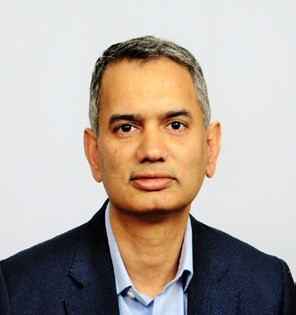Focus: Blockchain
Is the UK Healthcare Industry Ready to Harness the Potential of Big Data?
COVID-19 highlighted the need for data collection in the pharma industry to ensure collaboration between healthcare providers, patients, and the larger pharma companies. How important is continuing this digital collaboration in the future?
Venky Ananth at Infosys
For many years, the healthcare industry has been viewed as a laggard in adopting new technologies, compared to broader industry, and has suffered a significant digital gap to bridge. However, the pandemic has forced a change in behaviour from both patients and providers which has catalysed change and broken down barriers of major resistance in digital adoption.
In fact, the impact on the healthcare industry has been profound. The barriers to information sharing, both real and attitudinal, have diminished. The lack of transparency that prevailed in pharma and healthcare – often due to sheer inertia to adopt new digital technologies or ways of working and constraints around budget, skills, and regulation – has given way to greater collaboration and information sharing.
Likewise, healthcare systems that often held back information, fearing it would expose their inefficiencies, are now more open to sharing data. As a result, remote access to services and clinical trials, which were earlier accepted only on an experimental basis, have become more mainstream.
Digital adoption has been the most prominent factor that has shaped these trends. Practices such as remote triaging of the patient or online preliminary diagnosis have transformed patient care. This trend is set to continue in the future too, especially as technology adoption continues to gain traction. For instance, the global cloud computing market size is expected to reach $947.3 billion by 2026, growing at a compound annual growth rate (CAGR) of 16.3% (1).
This could have a profound impact on the quality of healthcare and improved life expectancy. For example, think about what a comprehensive digital platform that seamlessly connects clinicians with their patients could achieve. Data shared by patients on their treatments and experiences could help shape the treatment process and make it increasingly patient-friendly and effective. Over time, the platform could gather data across a spectrum of patients from different ethnicities, geographies, and so on.
Eventually, these could power Big Data insights to identify patterns and trends that can be then applied to carry out preventive healthcare measures among the entire population in a timely fashion.
This environment of collaboration could be the future of healthcare, powered by digital interventions enabled by AI and machine learning (ML) technology companies to bring together patients and the healthcare provider system in a seamless manner.
While this change is imminent, there are several steps that healthcare providers, pharma companies, and governments could take to make this a reality across the healthcare ecosystem.

Photo: National Cancer Institute (Unsplash)
Preparing the Technology Backbone
We now have an ecosystem of data sharing that is increasingly coming together and contributing information across various care settings including GPs, secondary care, community care, and also researchers. With technologies such as AI and analytics, organisations can not only ensure more personalised care for patients, but also identify health trends in the community, look at preventative care models, and more easily identify suitable candidates for clinical trials and research programmes.
Organisations must consider building these capabilities now since they will prove to be valuable as more data becomes available in the data sharing ecosystem. A platform approach can help connect key players in the ecosystem. These platforms connect providers to the payers and patients, where everyone has visibility into the information that is flowing through. Also, given the massive amount of data now available and accessible over the cloud, cybersecurity has never been more important. Organisations must therefore take greater efforts to not only protect patient data and ensure they are not misused in any manner, but also communicate these security measures with them.
Building Trust
In the UK, there has been a consistent trust deficit among the public when it comes to sharing information with pharma companies and other healthcare organisations. For some, the perception is that sharing personal data with Big Pharma will lead to exploitation of this information and a mark-up in prices. Given that pharma companies have a key role to play in the development of drugs as well as preventative care, building trust with patients is absolutely critical.
Yet, from a global perspective, data suggests that trust as a barrier to the digital healthcare revolution has in fact reduced thanks to the impact of the pandemic (2).
The pandemic has already redefined healthcare delivery models and has spurred a new openness to change amongst patients. Patients are more demanding now and willing to shop around for their ideal care experience that is convenient, connected, and enables them to better manage their health. According to a survey, an overwhelming 83% of patients say that they would like to continue using telehealth services after the pandemic, 34% patients are more likely to use wearables and digital health monitors, and they are also 103% more likely to share health data (3). The reluctance towards health data sharing is diminishing.
The key here is that healthcare organisations and many of our healthcare clients are focusing on amplifying their investments in data security and mobile security initiatives. This increased focus on human-centric design of healthcare applications – keeping patient experience at the centre of design priorities – will in turn drive greater engagement and trust in these systems.
Modern day healthcare applications that are designed after significant patient research and deep understanding of their needs can deliver seamless care experiences across multiple specialties, providing convenience and personalisation adapted to specific patient needs and context. As a result, we’re seeing patients feel more empowered to manage their condition and take control of their health, and thus more willing to provide permissions and access to certain data to which they will reap the benefit. The enhanced care experience through digital adoption is fast alleviating patient anxiety to cross over to digital health.
“ Eventually, these could power Big Data insights to identify patterns and trends that can be then applied to carry out preventive healthcare measures among the entire population in a timely fashion ”

Beyond individual organisations making progress to build trust, there is a fundamental need for greater cross-industry collaboration to really demonstrate the benefits and potential that greater data sharing can realise for patients and the healthcare system as a whole. We’re beginning to see an increasing number of consortiums bring together experts from universities, healthcare organisations, pharma companies, and even technology companies. These collaborations unify deep industry experts from every aspect of the healthcare system to share knowledge and understanding, in turn enabling greater innovation and the development of new patient-centric solutions.
Lobbying for Uniformity in Regulations
Currently, there is no consistency in the definitions and regulations surrounding healthcare data sharing. Just like in the banking industry, the healthcare industry, too, needs a mechanism and governance framework in which data are defined in a fashion that is commonly understood everywhere. The General Practice Data for Planning and Research (GPGDPR) process which the NHS initiated earlier this year is a great step in this direction. It lays down the process for GP data collection to support vital health and care planning, and research.
Patient data in general practice is valuable to help understand whether the health and care system is working for patients as a whole. It will also help to support the planning and commissioning of health and care services, the development of health and care policy, public health monitoring, and interventions. While fears continue around misuse of these data by large pharma companies, for example, the right governance and consumer trust will mitigate risks and could revolutionise the way care is managed and delivered for the better.
The overarching objective of any healthcare system is to improve population health and healthcare accessibility. Using Big Data in conjunction with technologies such as AI and ML has the potential to enable better healthcare to the public at large. Driving these investments in technology, reforming the regulatory landscape, and building trust will likely go a long way in building the healthcare system of the future.
References
2. Visit: www.ruby.com/infographic-telehealth-in-2021-and-beyond/

Venky Ananth, SVP and Global Head of Healthcare at Infosys, is responsible for the profitable growth of the Healthcare business. His responsibilities straddle business growth, industry strategy, product IP and service innovation, execution, and building high-performance teams. Venky manages critical relationships with senior client executives at Fortune 500 firms. As a software developer at heart, Venky drives a strong strategic orientation, takes pride in a ‘thinker-doer’ mindset, and is hyper-focused on leveraging technology to solve real-world business problems at scale.
He has spent over two decades in the technology industry including an entrepreneurial stint, with his experience spanning multiple industries and geographies. He had the honor of being listed as one of the Top 25 Healthcare IT Executives of 2020 by “The Consulting Report”. Venky has a BS degree in Mechanical Engineering and an executive leadership programme from Stanford Graduate School of Business, US.